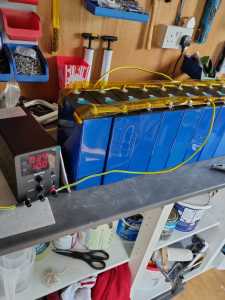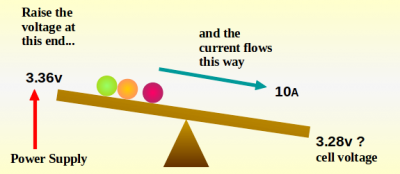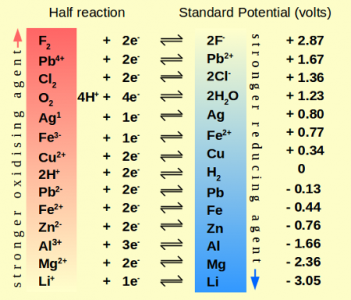I wonder if I should change my advice on top-balancing.
Should I recommend connecting the cells to the power-supply via an external/visible fuse?
To keep resistance low it would need to be a fuse in a holder with relatively large connection posts. And preferably the fuse itself should be bolted in place - not merely clipped into the holder.
Save energy... recycle electrons!
I don't think it matters too much. As long as they can charge it doesn't really matter. I'm not sure who is in a major rush. I just wasn't thinking when I connected the wires.
1. Is the power supply genuinely capable of delivering 10A? Or is it possibly a broad allusion to 10A, based on the rating of the components used inside?
2.Is the current measurement accurate? Check with an external multimeter,
3. I must emphasise - the quality of connections is extremely important. All wires need to be tightened onto terminals. Thus if you were to use crocodile clips to attach the power supply to the battery busbars, then you see a dramatic reduction in current. Tarnished copper also presents a higher resistance - ensure it's clean!
Save energy... recycle electrons!
Annoyingly I can't measure the current. I have two multimeters, one only measures AC current and the other measures DC but only on mA and doesn't have a suitable setting for that measurement. It does have a current adjustment, but I don't think I can use it as it's voltage controlled Vs current controlled. It's still charging and the voltage on the cells is increasing, it's just a slow game at the moment. My case isn't here, so no rush (yet)
Made some new connectors using left over wire connectors and some very thick cable. Now charging at 10a continuous current, aiming for 3.6v
Let's see how we get on!
@transparent by my calcs I have roughly another 29 hours of charging left to top balance.
Cells are currently at 3.36v, so 16 cells x 280ah = 15,053w of power stored currently
Desired state is 3.6v so that is 16,128w target
Its charging at 3.6v and 10amps = 36 watts per hour
(16128 - 15053) / 36 = 29.87 hours
Do I assume that you're reading that 3.36v from the meter on front of the psu?
That's not the cell voltage. The PSU voltage reading is defined such that it causes 10A to flow into the cells.
Based on the approximate State of Charge (SoC) of the EVE cells I've received from China this year, I'll predict the time taken for your cells to reach 3.6v is more like 15-18 days. 🙂
Background information for others who come across this topic later:
Lithium cells are not charged by the manufacturer before sale.
A typical post-assembly electrical test in the factory would include measurement of the internal resistance and the ability of each cell to receive a charge current of around 2C for about a minute. C is the Ah rating of the cell. So a 280Ah cell would be tested at 2 x 280 = 560A
The voltage of the cell is dictated by its chemistry, according to the universal electro-chemical series:
In our case, the Lithium Ferrous Phosphate (LiFePO4) is the cathode, whilst the anode is graphite (carbon) with a metallic backing. If you put those two materials together as thin films on a laboratory bench with an electrolyte liquid between them, electrons will flow, and you can measure a potential difference of 3.2v - which tells you nothing about the amount of charge held by those two plates.
A manufacturer will develop a method of assembly which gives them a predictable cell capacity. Thus EVE have designed a manufacturing process which yields cells of around 280-290Ah capacity. They then offer those for sale with a 280Ah specification.
The only way to find out the actual capacity of a cell you've bought is to charge it fully (to around 3.65v) and then discharge it at a current less than C to about 2.8v. (Outside those voltages risks damaging the cell).
You then verify that capacity by charging it back up again, which will obviously take a slightly greater amount of electricity due to internal losses.
If you intend doing capacity tests on cells more than a couple of times, then consider investing in a proper Capacity Load-tester. This takes a constant-current through a heating element whilst measuring the discharge characteristics. The data is streamed to a PC via a USB lead, enabling you to see the resulting graph.
Save energy... recycle electrons!
So are you measuring that voltage with the cells still charging?
Even if the PSU is disconnected, you will need to allow the cells to 'rest' for about 20 mins, and then connect a small load. You need something drawing between 1-10A. That will then allow you to obtain a reasonable measurement of the real cell voltage.
Save energy... recycle electrons!
- 26 Forums
- 2,118 Topics
- 46.5 K Posts
- 19 Online
- 4,522 Members
Join Us!
Latest Posts
-
@majordennisbloodnok Thank you. I have sent a very ster...
By El3b , 31 minutes ago
-
Fitting new shower valve ..........
This may be too generic but I need to change the ...
By Lenny , 2 hours ago
-
RE: Replacing Refrigerant on Mitsubishi Heat Pump
So the manual is correct and looks fine to me, to abbre...
By ASHP-BOBBA , 6 hours ago
-
RE: Heat Pump Books For Beginners – Bodge Buster & From Zero To Heat Pump Hero
Hi I, like others, avoid Amazon for ethical reasons....
By Topher , 7 hours ago
-

RE: Benefits of an extra horizontal loop for GSHP
I would deffo install an additional slinky run, especia...
By Transparent , 7 hours ago
-
RE: Say hello and introduce yourself
@editor fab - thanks Mars, and keep up the great work o...
By normpang , 8 hours ago
-
RE: Compressor and Evaporator Stratification
@trebor12345 So I think the 1st zigzag section shows so...
By ASHP-BOBBA , 23 hours ago
-

RE: Is this just haze or something more?
@majordennisbloodnok I was giving a talk to primary sch...
By Toodles , 1 day ago
-
RE: Tesla Powerwall – More of a ‘Luxury’ Than an ROI Winner!
We had our Tesla Powerwall 3 (and Gateway) installed ea...
By Old_Scientist , 1 day ago
-
Indeed. With a battery its presumably the battery con...
By JamesPa , 1 day ago
-
RE: No-code, plug-and-play monitoring for your heat pump
To update an ESP device using ESPHome in Home Assistant...
By Grantmethestrength , 2 days ago
-

RE: The good, the bad and the not that great – my heat pump installation
Said I would pop back with a update. Only Mr Jesus h...
By Burtis , 5 days ago
-
RE: Buffers, hot water and cooling
Thats presumably heat pump DT, what about radiator DT a...
By JamesPa , 5 days ago
-
RE: Who's your electricity provider and what's your tariff?
@chandykris Exactly the same here. We now have 13.5kWh ...
By Old_Scientist , 5 days ago
-
RE: Wood burner with ASHP - direct air?
This depends on the size of your wood burner and size/t...
By Lucia , 6 days ago
-
RE: Difficult positioning of air source heat pump
@rikiarn It's a not a buffer it's a volumiser which is ...
By Lucia , 6 days ago
-
RE: Is your heat pump insured?
To make things clear, lots of insurance companies cover...
By Lucia , 6 days ago
-
RE: Boxt Heat Pump Installation Experience
@adrian any updates since installation? How is it perfo...
By Ashfp , 6 days ago
-

@seatonian got your email. Will connect you with a reco...
By Mars , 1 week ago
-

@downfield and @toddles, this isn’t in the settings cur...
By Mars , 1 week ago







